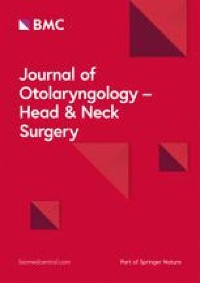|
Medicine RSS-Feeds by Alexandros G. Sfakianakis,Anapafseos 5 Agios Nikolaos 72100 Crete Greece,00302841026182,00306932607174,alsfakia@gmail.com
Πληροφορίες
Κυριακή 15 Αυγούστου 2021
Office‐Based Procedure Training in Laryngology Fellowship Programs
Laryngeal Pathologies Associated with the Genre of Singing and Professional Singing Status in a Treatment‐Seeking Population
|
Current Practices in Endotracheal Tube Size Selection for Adults
|
Auditory Feedback Control of Vocal Pitch in Spasmodic Dysphonia
|
Intracordal Injection of Basic Fibroblast Growth Factor in 100 Cases of Vocal Fold Atrophy and Scar
|
Abnormal Laryngeal Electromyography Findings in Asymptomatic Adults Across the Age Spectrum
|
Factors influencing rehabilitation effect in prelingually deafened late implanted cochlear implant users, and the construction of a nomogram
|
Quantification of endolymphatic hydrops and its correlation with Meniere’s disease clinical features
|
The power and potential of BIOMAP to elucidate host‐microbiome interplay in skin inflammatory diseases
|
Combination of the endoscopic septonasal flap technique and bioabsorbable steroid-eluting stents for repair of congenital choanal atresia in neonates and infants: a retrospective study
|
Radioactive iodine does not improve overall survival for patients with aggressive variants of papillary thyroid carcinoma less than 2 cm
|
Αρχειοθήκη ιστολογίου
-
►
2023
(366)
- ► Φεβρουαρίου (184)
- ► Ιανουαρίου (182)
-
►
2022
(2814)
- ► Δεκεμβρίου (182)
- ► Σεπτεμβρίου (213)
- ► Φεβρουαρίου (264)
- ► Ιανουαρίου (262)
-
▼
2021
(3815)
- ► Δεκεμβρίου (229)
- ► Σεπτεμβρίου (276)
-
▼
Αυγούστου
(399)
-
▼
Αυγ 15
(25)
- Office‐Based Procedure Training in Laryngology Fel...
- Laryngeal Pathologies Associated with the Genre of...
- Current Practices in Endotracheal Tube Size Select...
- Auditory Feedback Control of Vocal Pitch in Spasmo...
- Intracordal Injection of Basic Fibroblast Growth F...
- Abnormal Laryngeal Electromyography Findings in As...
- Factors influencing rehabilitation effect in preli...
- Quantification of endolymphatic hydrops and its co...
- The power and potential of BIOMAP to elucidate hos...
- Combination of the endoscopic septonasal flap tech...
- Radioactive iodine does not improve overall surviv...
- Seasonal expression and distribution of kisspeptin...
- Impact of Biologic Therapies on Surgery for Chroni...
- Paraganglioma of the Thyroid Gland: A Case Report ...
- Endoscopic-Assisted Fronto-Orbital Distraction Ost...
- A systematic review and meta-analysis of iliocapsu...
- Association of Perioperative Complications with Vi...
- Canadian consensus statement on the management of ...
- Voice Changes Without Laryngeal Nerve Alterations ...
- Prevalence of Laryngopharyngeal Reflux Symptoms, D...
- Vocal Fold Submucosal Mesna Injection and Microfla...
- Evolution of incidence of audiovestibular disorder...
- Hydraulic insertions of cochlear implant electrode...
- Dynamic analysis for flexion and extension of elbo...
- Self-Perceived Voice Handicap during COVID19 Compu...
-
▼
Αυγ 15
(25)
- ► Φεβρουαρίου (64)
-
►
2020
(5754)
- ► Δεκεμβρίου (401)
- ► Σεπτεμβρίου (365)
- ► Φεβρουαρίου (754)
- ► Ιανουαρίου (894)
-
►
2019
(146)
- ► Δεκεμβρίου (19)
- ► Σεπτεμβρίου (54)




